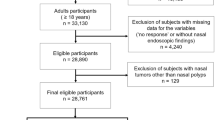Abstract
Design
A case–control study was carried out in Chennai, South India.
Participant selection
All subjects (cases and controls) were recruited from the outpatient department of Ragas Dental College and Hospital, Chennai. The cases were patients who had either reported for treatment of oral submucous fibrosis (OSF) or who had been diagnosed with OSF during routine oral examination. The clinical diagnosis was confirmed by biopsy in every case using established criteria. The control patients were chosen using a random selection method, in which every fifth patient of the outpatient department would be included. These individuals had no oral lesions other than periodontal disease associated with a chewing or smoking habit. One control was then selected for each case, matched by age (±2 years) and gender. All chewers in case and control groups used some form of areca nut at least once a day.
Data analysis
The habits of cases and controls were classified into various categories without any overlap. Statistical tests were performed to find out if there was any significant difference in the duration, frequency and intensity of all habits between cases and controls. Univariate binary logistic regression was used to ascertain the significance of risk factors for the cases.
Results
A total of 185 consecutive patients with OSF were assigned corresponding age- and sex-matched controls. The male to female ratio of OSF cases was 9.9:1.0. All areca nut products were associated with OSF (Table 1), with the risk being greatest for pan masala (processed areca nut without betel leaf; odds ratio, 81.5). This was followed by areca nut plus alcohol use (odds ratio, 69.9). Smoking and alcohol, together or on their own, did not show any correlation with the occurrence of OSF but their concurrent use along with processed areca nut increased the risk of OSF (P<0.05). Both duration and intensity of habit showed a statistically significant difference between the cases and controls (P<0.002 and P<0.005, respectively). There was no significant difference in the frequency of chews per day between the cases and controls.
Conclusions
The present study confirms the strong association between areca nut use and OSF and between OSF and the increasing use of pan masala.
Similar content being viewed by others
Commentary
OSF is a clinically significant disorder characterised by fibrosis of the submucosal tissues of the mouth, which limits movement of the oral mucosae and tongue, giving rise to microstomia and eventual dysarthria and dysphasia. There is a significant risk of potentially-malignant and malignant disease with OSF. The condition is predominantly caused by long-term use of areca nut-containing agents and agents, although it may also have a genetic basis. The epidemiology of OSF reflects geographically- and ethnically-related use of areca nut products and thus is most common in areas of the Indian subcontinent.
This work by Ranganathan and colleagues comprises a case–control study of individuals resident in southern India, with and without clinical features of OSF, to establish the association between OSF and the use of tobacco, areca nut (and areca nut-containing agents such as betel quid and pan masala) and alcohol.
The presence of OSF was confirmed histopathologically in the case patients. The control patients were systematically selected from an allied outpatient clinic (although this was described as “random” by the authors) and were age- and gender-matched to the case subjects. The oral disease of the control subjects that necessitated attendance at an outpatient clinic is not stated.
The results of the study indicate that OSF is significantly associated with use of pan masala and pan masala plus areca nut, with or without concurrent alcohol use. Tobacco smoking and use of alcohol without use of areca nut products is not associated with OSF. The results thus revealed that areca nut and areca nut-containing agents, with or without alcohol or tobacco, are of likely aetiological significance in the development of OSF. In particular, individuals using pan masala plus alcohol are particularly at risk of OSF. Tobacco or alcohol were not risk factors for OSF, whether taken alone or in combination.
The investigation did not include histopathological examination of the oral mucosa of control subjects, so it is possible that the study may overestimate the risk of OSF associated with areca nut-related agents. The very high OR values associated with use of areca nut agents, however, does suggest that an aetiological link with OSF is highly likely.
There remains no effective clinical method of reducing the severity of OSF, nor its potential to give rise to oral squamous cell carcinoma. The significant finding of OSF being associated with areca nut, pan masala (with and without alcohol), suggest that there is a need to enhance strategies that increase public awareness of the risks of use of areca nut agents, or to develop strategies to limit the availability of such agents. Effective public health promotion initiatives are more likely to have an immediate effect upon the epidemiology of OSF than any innovative in-vitro research.
Practice point
-
The very high odds ratios associated with OSF and use of areca nut agents suggests an aetiological link is highly likely. Effective public health initiatives are more likely to impact on the epidemiology than innovative research.
Acknowledgements
The author acknowledges Dr David Moles, Senior Clinical Lecturer, Health Services Research, Eastman Dental Institute, University College London, London, UK for helpful discussions concerning this report.
Author information
Authors and Affiliations
Additional information
Address for correspondence: Dr K Ranganathan, Department of Oral Pathology, Ragas Dental College and Hospital, 2/102 East Coast Road, Uthandi, Chennai 600 119, India. E-mail: ran2@vsnl.com.
Ranganathan K, Devi MU, Joshua E, Kirankumar K, Saraswathi R. Oral submucous fibrosis: a case-control study in Chennai, South India. J Oral Pathol Med 2004; 33:274–277
Rights and permissions
About this article
Cite this article
Porter, S. Strong association between areca nut use and oral submucous fibrosis. Evid Based Dent 7, 79–80 (2006). https://doi.org/10.1038/sj.ebd.6400434
Published:
Issue Date:
DOI: https://doi.org/10.1038/sj.ebd.6400434


